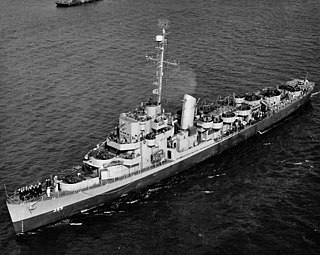
The first USS Haraden (DD–183) was a Wickes-class destroyer in the United States Navy in the period following World War I. She was later transferred to the Royal Canadian Navy as HMCS Columbia, as a Town-class destroyer.

USS Dahlgren (DD-187/AG-91) was a Clemson-class destroyer which served in the United States Navy during World War II. Entering service in 1920, the ship had a brief active life before being placed in reserve in 1922. Reactivated in 1932, Dahlgren remained in service mainly as a test ship until 1945. She was sold for scrapping in 1946. She was named for Rear Admiral John A. Dahlgren (1809–1870), and was the second ship of three which served in the US Navy to receive the name.

USS Hatfield (DD-231/AG-84) was a Clemson-class destroyer in the United States Navy during World War II. She was named for John Hatfield, killed in action 1813. As of 2021, no other ship of the U.S. Navy has been named Hatfield.

USS Eberle (DD-430) was a Gleaves-class destroyer of the United States Navy. The ship is named for Rear Admiral Edward Walter Eberle, who commanded the Atlantic and Pacific Fleets and was Chief of Naval Operations from 1923 to 1927. The destroyer entered service in 1940 and spent the majority of her career in the Atlantic Ocean. Placed in reserve following the war, the ship was transferred to the Hellenic Navy in 1951. Renamed Niki, the destroyer remained in service until 1972 when she was scrapped.
USS Milledgeville (PF-94), a Tacoma-class frigate, was the first ship of the United States Navy to be named for Milledgeville, Georgia.
USS Chickadee (AM-59) was an Auk-class minesweeper of the United States Navy, named after the Chickadee, a family of small passerine birds which appear in North America and Africa.

USS Stockdale (DE–399) was an Edsall-class destroyer escort in service with the United States Navy from 1943 to 1947. She was sunk as a target in 1974.

USS Chief (AM-315) was an Auk-class minesweeper acquired by the United States Navy for the dangerous task of removing mines from minefields laid in the water to prevent ships from passing, and named after the word "chief," the head or leader of a group.
USS Cotinga (AMc-43), a U.S. Navy Accentor-class coastal minesweeper built for the U.S. Navy for service in World War II, was named after the cotinga, a passerine bird of South America and Central America.
USS Jacamar (AMc-47) was an Accentor-class coastal minesweeper of the U.S. Navy. She was built for service during World War II and named after the jacamar.
USS Adamant (AMc-62) was an Accentor-class minesweeper in the United States Navy during World War II.

USS Huse (DE-145) was a U.S. Navy destroyer escort launched by Consolidated Steel Corp., Orange, Texas on 23 March 1943, during World War II. The ship was sponsored by Mrs. L. M. Humrichouse, daughter of Admiral Harry McLaren Pinckney Huse, whom the ship was named after and commissioned on 30 August 1943.

USS Owl (AM-2) was an Lapwing-class minesweeper acquired by the U.S. Navy for the dangerous task of removing mines from minefields laid in the water to prevent ships from passing.
The third USS Curlew (AM-69/IX-170) was a Catbird-class minesweeper in the United States Navy during World War II.

USS Wassuc (CMc-3), originally a steel-hulled, coastal passenger vessel built in 1924 at Elizabethport, New Jersey, by the New Jersey Drydock and Transportation Corp. of New York City as SS Yale, was acquired by the U.S. Navy on 20 December 1940. SS Yale then began conversion to a coastal minelayer at the New York Navy Yard. Classified CMc-3 on 30 December 1940 and renamed USS Wassuc on 10 January 1941, the ship was commissioned at the New York Navy Yard on 15 May 1941.
USS PCS-1465 was a PCS-1376-class minesweeper built for the United States Navy during World War II. Late in the war she was renamed and reclassified Minah (AMc-204), and in the 1950s reclassified first as AMCU-14 and later as MHC-14. Named for the myna under a variant spelling, she was the only U.S. Navy ship of that name.
USS Cardinal was a YMS-1-class minesweeper of the YMS-135 subclass built for the United States Navy during World War II. She was the third ship in the U.S. Navy to be named for the cardinal.

USS Linnet (AM-76), was a Kite-class minesweeper of the United States Navy during World War II.

USS Tomich (DE-242) was an Edsall-class destroyer escort in service with the United States Navy from 1943 to 1946. She was scrapped in 1974.
USS Crag (AM-214) was an Admirable-class minesweeper built for the United States Navy during World War II. She was originally ordered, laid down, and launched as USS Craig (AM-214), but was renamed Crag in August 1944. She was awarded one battle star for service in the Pacific sweeping mines after the end of World War II. She was decommissioned in March 1948 and placed in reserve. While she remained in reserve, Crag was reclassified as MSF-214 in February 1955 but never reactivated. In 1962, she was sold to the Mexican Navy and renamed ARM DM-15. Her ultimate fate is not reported in secondary sources.










